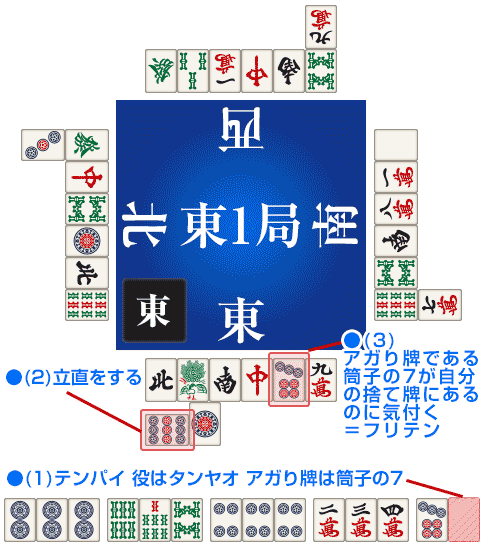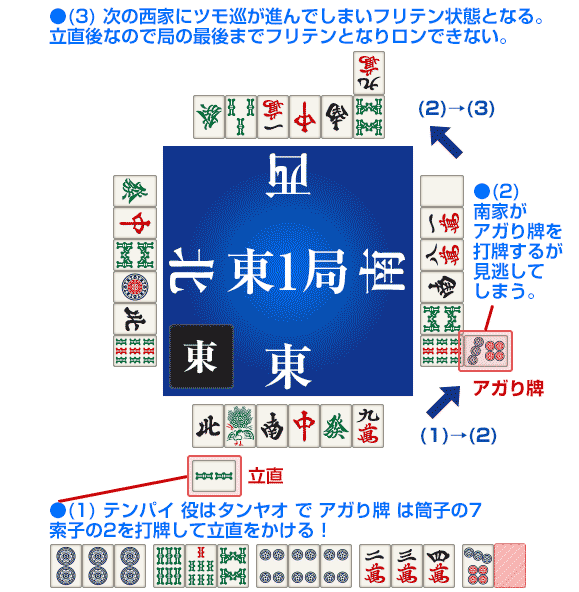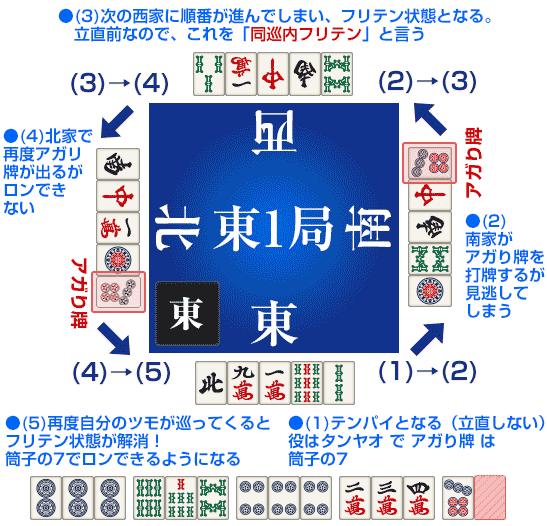Furiten – How mahjong is played.
What is Furiten?
Furiten refers to a state where, after reaching tenpai, the winning tile (atari hai) exists in your discard pile (kawa). If you are in a Furiten state, you cannot win by Ron (declaring a win on another player's discard).
If you mistakenly call Ron while in a Furiten state, it will result in a penalty (chombo).
Even if there are multiple winning tiles in a wait such as a two-sided wait (ryanmen), Furiten applies if just one of those tiles is in your discard pile, and you cannot win by Ron in that tenpai.
This is the basic concept of Furiten, but there are additional rules to remember, such as "same-turn Furiten" when you miss a winning tile discarded by an opponent, or differences in handling Furiten depending on whether you've declared Riichi or not. Make sure to learn these thoroughly!
The Disadvantage of Being Unable to Ron
Ron refers to winning by declaring on another player’s discard. Since there are three other players, the chance of winning by Ron is roughly three times the chance of winning by Tsumo (drawing the winning tile yourself).
Being unable to Ron is thus a significant disadvantage.
Additionally, if your Furiten state becomes apparent, it can work to the advantage of your opponents. Therefore, it's crucial to maintain a calm demeanor and conceal your mistake of being in Furiten.
Furiten is not just a reduction in your winning chances—it also carries a psychological toll as a significant mistake.
Two Conditions That Lead to Furiten
- Furiten due to Discards: When in tenpai, if any winning tile exists in your discard pile.
- Furiten due to a Miss: When in tenpai, if you miss a winning tile discarded by another player by not declaring Ron.
While both cases result in Furiten, the handling differs depending on whether you have declared Riichi.
Specific Examples of Furiten
Let’s look at specific examples of Furiten.
Furiten due to Discards
Take a look at the following image, which shows an example where the East player (at the bottom of the image) is in Furiten.

The East player has reached tenpai with a tanyao hand and declared Riichi after discarding . The winning tile is .
However, upon closer inspection, the winning tile is present in the player’s discard pile. This is a case of Furiten due to discards.
As a result, the East player can only win by drawing the winning tile themselves (Tsumo).
Pay Attention to Discards Used for Calls!
A commonly overlooked scenario involves tiles that were called (Pong, Chi, or Kan) by other players.
If a tile you discarded is called by another player, it is removed from your discard pile and added to their hand.
These tiles still count toward Furiten. Therefore, you must keep track not only of your discard pile but also of tiles you discarded that were called by others.
How to Handle Furiten due to Discards
- Win by Tsumo.
- Break your tenpai and restart your hand.
- Fold (Betaori) if the situation calls for it.
In the above example, since the player has declared Riichi, their only option is to wait for a winning tile through Tsumo.
If Riichi has not been declared, it is possible to change your hand and avoid Furiten.
For example, in this hand (assuming no Riichi), keeping the next drawn tile and discarding changes the winning tile, effectively clearing the Furiten state.
Whether you should break your tenpai to avoid Furiten or rely on Tsumo depends on the situation.
If it's early in the game and the hand isn't too valuable, breaking your hand and starting over might be an option. If you sense other players are in tenpai, it may be better to fold without being stubborn.
Furiten due to a Miss
Next, let’s consider an example of Furiten due to a missed Ron opportunity.

The East player (at the bottom of the image) declared Riichi and reached tenpai with a tanyao hand but missed the opportunity to call Ron on a winning tile right after.
In this case, once the West player draws their tile, Furiten is established.
Similar to Furiten due to discards, the East player can now only win by drawing their winning tile themselves.
Same-Turn Furiten
In the case of Furiten due to a missed Ron, if you have not declared Riichi, the Furiten state can be automatically cleared in the next turn under the "same-turn Furiten" rule.
Here is an example of same-turn Furiten:

Here’s the sequence of events:
- The East player discards and reaches tenpai. The winning tile is .
- The South player discards , but the East player misses the opportunity to call Ron.
- The West player draws a tile, establishing same-turn Furiten.
- The North player discards , but the East player cannot call Ron due to same-turn Furiten.
- Once the turn cycles back to the East player, the Furiten state is cleared since it is no longer the same turn.
In this way, Furiten due to a missed Ron can be cleared after one turn if you have not declared Riichi, making it different from Furiten due to discards.
How to Handle Furiten due to a Miss
- Win by Tsumo.
- Wait for same-turn Furiten to clear.
If you have declared Riichi, the situation is the same as Furiten due to discards, and you must rely on winning by Tsumo.
However, if you have not declared Riichi, same-turn Furiten clears after one round, so there is no need to change your hand or fold. This is a key difference compared to Furiten due to discards.






Please send us your comments.